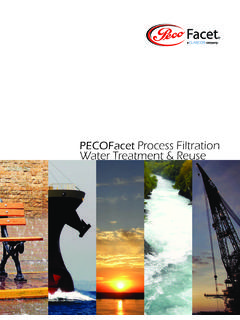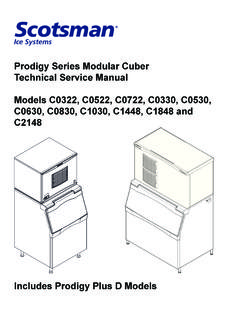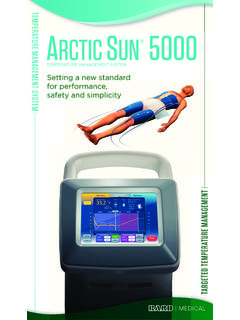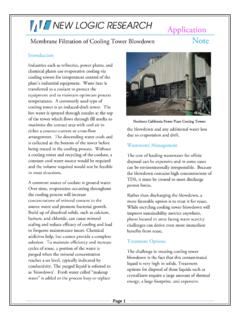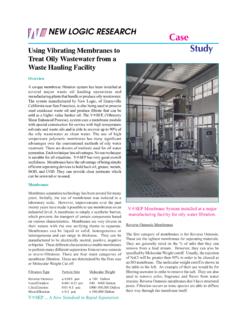Transcription of Waste To Energy Water & Sewage Sludge Drying
1 Waste To Energy Water & Sewage Sludge Drying MSW, Sludge , Manure & Food Waste to Energy January 2011. Sewage Sludge treatment Many wastewater treatment plants are coping with a Waste stream of digested Sludge . The Sludge is normally dewatered by means of a centrifuge or belt filter press. After dewatering the Sludge has a typical dry solids content of approx. 20 - 25%. Every country has a lot of problem with the fast increasing Sludge , shortage of Sewage treatment plant and limitation of landfill size. The volume is increased by 10%-20% every year by building up new Sewage plant in every country. How can we treat these increasing Sludge ? We are not allowed to dump the Sludge to sea. I think the best solution is to covert Sludge to Energy , which is possible when we dry Sludge less than 10% Water content and then possible to use Sludge for the gasification and power generation which will be treated by Devolatization or gasification equipment.
2 The dried Sludge (Bio-Solid) can be applied as a fertilizer to improve and maintain productive soils and stimulate plant growth. They are also used to fertilize gardens and parks and reclaim mining sites. landfill with 4/1-5/1. reduction of volume, incineration, fuel for cement plant and also fertilizer depending upon heavy metal means economic Drying of around 80% Sludge to dried Sludge less than 10 % Water content would be the key solution to save the world Here is the patented Microwave Near Infrared Ray system (MW-NIR).. Drying any Sludge , manure and Waste food to 10%-0% and also integrate with Devolatization or gasification system and power We can generate around 1 MW electric power and/or syngas from 100 tons per day 80% or dried Sludge can be used for landfill, fertilizer, bio-coal and requires 1~2 million dollars of investment for complete Drying system plus special filter if including gasification and power generation system will need 6 million dollars ( 1-2 million dollars Drying system + 6 Million dollars of gasification and power generation.)
3 This systems are modular type and can be installed one by one separately for Drying system , gasification system , and power generation subject to the budget and purposes.. Five Typical Sludge treatment What is in Dried Sludge ? What is in Dried Sludge ? Dried Sludge are mainly a mix of Water and organic materials that are a by-product of the Sewage treatment processes. Most wastewater comes from household kitchens, laundries and bathrooms. Dried Sludge may contain: Macronutrients, such as nitrogen, phosphorus, potassium and sulphur and Micronutrients, such as copper, zinc, calcium, magnesium, iron, boron, molybdenum and manganese. Dried Sludge may also contain traces of synthetic organic compounds and metals, including arsenic, cadmium, chromium, lead, mercury, nickel and selenium.
4 These contaminants limit the extent to which Dried Sludge can be used, with all applications regulated by appropriate government authorities. Every country has one of the strictest regulatory regimes for Dried Sludge production and application in the world. What are Dried Sludge used for? Dried Sludge can be applied as a fertilizer to improve and maintain productive soils and stimulate plant growth. They are also used to fertilize gardens and parks and reclaim mining sites. The applications are : Co-generation/power production/ Energy recover Land application in agriculture (vine, cereal, pasture, olive). Road base, Land application in forestry operations, Land rehabilitation (including landfill capping).
5 Landscaping and topsoil, Composting, Incineration, Landfill Gas and Oil from Sludge , Bricks and construction material Bio-fuel ( Bio-Coal), Fuel substitute (cement works), etc. Project Various Water Sludge treatment Project Drying and Power Generation. Microwave Near Infrared Ray (MW-NIR) Drying system 80% Moisture Sludge 50-60% Moisture Sludge 10% Sludge modular Package Drying system for 100 Tons per Day and 300 Tons per Day. Drying for landfill, reclamation, fertilizer, fuel for cement plant, etc . Dried Sludge less than 10% moisture for gasification and power generation modular Package for MW-NIR Dry and Gasification based on 100 tons/day No competitor in the price and function of Drying Sludge in the world Start the project 100 tons/day and 300 tons/day for Drying & Gasification Low investment and high profit return rate and lower O&M SOLUTION.
6 1 Drying 80% Sludge to 10% Sludge by Microwave-Near Infrared Ray (MWNIR). - Landfill ( Volume is reduced t to 1/4 - 1/5 ) or Incineration - Reclamation and fertilizer subject to heavy metal 2. Dried Sludge Devolatization Fuel & Gas Power Generation 3. Clean Fuel and Hydrogen for industries, home and car. What is Microwave Near Infrared? Main technology is to use both Microwave and NIR(Near Infrared Rays) heating technology simultaneously in the Drying processes Microwave causes vibrations and cracks among molecular particles with heat and then high penetration of IR actually increases surface moisture levels from the inner part. Features & Benefit Features Combination of Microwave- NIR(Near Infrared Rays) makes uniform heating and hard-to-dry object possible Saves Energy because not the atmosphere but the object itself is heated , Direct heating, not heat conduction Achieved the top efficiency of heating amounting to 80% above Sterilization of micro-organism by destroying and evaporating internal Water by MW-NIR.
7 Reliable with an intelligent service and maintenance concept Dry Smart & Green : Environment-friendly solution because of the minimum emissions of secondary pollutants (dust, CO, CO2, NOx, SOx, etc.) by use of ONLY electric Energy Benefits Reduction of processing cost through highly efficient Energy use Destroys 100% of pathogens Integrates easily with all dewatering machinery Reduction in emissions and foul odors Easy to maintain with simplified facility with the use of PLC(Programmable Logic Control). Immediate warm up and cool down - no waiting time Multiple-phase integrated installations, small sites possible and scalable depending on volume Patent Patents Reg. No. Sludge Drying method and apparatus 10-0539413.
8 Waste Water evaporation method and apparatus 10-0540165. Exhaust gas processing device for Energy efficient using of microwave electric heating element and 10-0794238. plasma ultraviolet rays lamp Exhaust gas processing device for Energy efficient 10-0794236. using of microwave electric heating element Apparatus for Drying processing object containing 10-0608296. moisture An apparatus and method for rapid Drying Sludge 10-0928277. NET(New Excellent Technology) Certificate No. 277: Waste Water Sludge Drying technology by the simultaneous use of Microwave and NIR(Near Infrared Rays) Energy Efficiency ( ). Applicable New Technology Certificate by LH Corp. Drying Plant by using both Microwave and NIR.
9 ( ). Technology Summary MW-Advantages MWNIRTM Plant in Operation Chemicals Co., Ltd. dries The Hardest-to-Decompose material of PNS(Poly Naphtalene Sulfonate) Waste gypsum and recycles it. MWNIRTM Plant in Operation Recent MWNIR TM Plants Ordered Provided 1 set of MW-NIR Drying plant in Gangneung Sewage Plant ~. and acquired NET(New Excellent Technology) Certificate No. 277 from the Ministry of Environment - MBC News Won the bid of Waste Water treatment technology in Gyeryong city in a consortium with Taeyoung Construction company and Entec company Provided 1 set of mobile MW-NIR Drying plant for Ecowave LLC(a wholly owned subsidiary of Natural Blue Resources, Inc., Nasdaq listed company) - Orange peel dryer Has contracted to provide a total of 50 sets of MW-NIR Drying plants by the end of 2011.
10 Won the bid of Waste Water treatment technology in Gimcheon city in a consortium with Taeyoung Construction company and Entec company MWNIRTM Structure MWNIRTM consists of several modules, including main frame, chambers, screws, hopper, magnetrons, Infrared lamps, generators, and control panel. The unheard-of our technology named MWNIRTM originates from the combined synergy of microwave and near infrared wave. Accordingly, Magnetrons and infrared lamps are used in our patent-acquired technology system . The MWNIRTM helps various industries and factories whoever wants to dry their product or Sludge , eventually to recycle them. For example, petrochemical or fertilizer factories can optimize the work process fully b y using our MWNIRTM.
